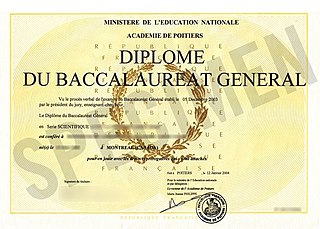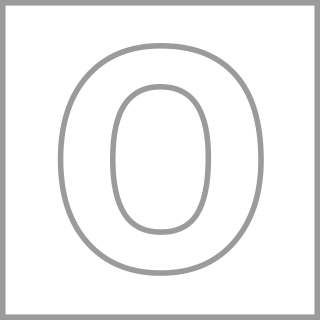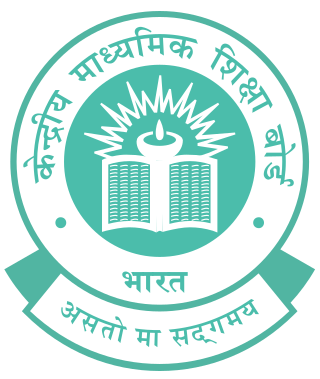
The General Certificate of Secondary Education (GCSE) is an academic qualification in a range of subjects taken in England, Wales and Northern Ireland, having been introduced in September 1986 and its first exams taken in 1988. State schools in Scotland use the Scottish Qualifications Certificate instead. However, private schools in Scotland often choose to follow the English GCSE system.

The baccalauréat, often known in France colloquially as the bac, is a French national academic qualification that students can obtain at the completion of their secondary education by meeting certain requirements. Though it has only existed in its present form as a school-leaving examination since Emperor Napoleon Bonaparte's implementation on March 17, 1808, its origins date back to the first medieval French universities. According to French law, the baccalaureate is the first academic degree, though it grants the completion of secondary education. Historically, the baccalaureate is administratively supervised by full professors at universities.
Education in Malaysia is overseen by the Ministry of Education. Although education is the responsibility of the Federal Government, each state and federal territory has an Education Department to co-ordinate educational matters in its territory. The main legislation governing education is the Education Act 1996.
The Hong Kong Certificate of Education Examination was a standardised examination between 1974 and 2011 after most local students' five-year secondary education, conducted by the Hong Kong Examinations and Assessment Authority (HKEAA), awarding the Hong Kong Certificate of Education secondary school leaving qualification. The examination has been discontinued in 2012 and its roles are now replaced by the Hong Kong Diploma of Secondary Education as part of educational reforms in Hong Kong. It was considered equivalent to the United Kingdom's GCSE.
The Hong Kong Advanced Level Examination, or more commonly known as the A-level, conducted by the Hong Kong Examinations and Assessment Authority (HKEAA), was taken by senior students at the end of their matriculation in Hong Kong between 1979 and 2012. It was originally the entrance examination in University of Hong Kong until the introduction of the Joint University Programmes Admissions System (JUPAS) in 1992, which made it the major university entrance examination until academic year 2011/2012.

The Malaysian Higher School Certificate, commonly abbreviated as STPM, is a pre-university examination in Malaysia. It was formerly known as the Higher School Certificate (HSC). Since 1982, STPM has been administered by the Malaysian Examinations Council (MEC), a statutory council under the Ministry of Education.
The Primary School Leaving Examination (PSLE) is a national examination in Singapore that is administered by the Ministry of Education and taken by all students near the end of their sixth year in primary school before they move on to secondary school. The examination test students' proficiency in the English language, their respective mother tongue languages, mathematics and science. Students have about two hours to complete each subject paper except for certain components of language subjects. Students answer multiple choice questions by shading their responses on a standardized optical answer sheet (OAS) that uses optical mark recognition to detect answers or by writing their workings and/or answers on the question booklet itself for certain sections of the paper.

The Sijil Pelajaran Malaysia (SPM), or the Malaysian Certificate of Education, is a national examination sat for by all fifth-form secondary school students in Malaysia. It is the equivalent of the General Certificate of Secondary Education (GCSE) of England, Wales and Northern Ireland; the Nationals 4/5 of Scotland; and the GCE Ordinary Level of the Commonwealth of Nations. It is the leaving examination of the eleventh grade of schooling.
The Singapore-Cambridge General Certificate of Education Ordinary Level is a GCE Ordinary Level examination held annually in Singapore and is jointly conducted by the Ministry of Education (MOE), Singapore Examinations and Assessment Board (SEAB) and the University of Cambridge Local Examinations Syndicate (UCLES). Students are graded in the bands ranging from A to F and each band has a respective grade point, a lower grade point indicates poor performance. The number at the end of each grade corresponds to the grade point that they receive. To pass an individual O-Level subject, a student must score at least C6 or above. The highest grade a student can attain is A1.

Penilaian Menengah Rendah was a Malaysian public examination targeting Malaysian adolescents and young adults between the ages of 13 and 30 years taken by all Form Three high school and college students in both government and private schools throughout the country from independence in 1957 to 2013. It was formerly known as Sijil Rendah Pelajaran. It was set and examined by the Malaysian Examinations Syndicate, an agency under the Ministry of Education.

This is a chinese school

Founded in 1918, Jit Sin High School is a co-educational Chinese vernacular secondary school in Bukit Mertajam, Penang.
In India, board examinations refer to the public examinations that are conducted at the completion of secondary and senior secondary education.

A Chinese independent high school is a type of private high school in Malaysia. They provide secondary education in the Chinese language as the continuation of the primary education in Chinese national-type primary schools. The main medium of instruction in these schools is Mandarin Chinese using simplified Chinese characters.

The O-Level is a subject-based qualification conferred as part of the General Certificate of Education. It began in the United Kingdom and has been adopted, often with modifications, in several other countries.

SMJK Sam Tet is a national-type Chinese-based Roman Catholic secondary school for boys located in Ipoh, Perak, Malaysia. It is located adjacent to its primary school, SJK (C) Sam Tet. The school's form 6 classes are available to both boys and girls, with former girls from SMJK Ave Maria Convent, Ipoh being the biggest population of girls. The school was nominated for School of Excellence in 2007 and for Cluster School of Excellence in 2015.

Convent Datuk Keramat High School is a school located in George Town, Penang, Malaysia. The school is an all-girls Chinese school with primary and secondary schools within the same compound. The Primary School is one of the 40 Convent primary schools in Malaysia while the Secondary School is one of the 30 Convent secondary schools in Malaysia. Among these schools, there are only 3 Chinese Convent schools in Peninsular Malaysia, one in Penang, one in Ipoh and one in Malacca.

The Central Board of Secondary Education (CBSE) is a national level board of education in India for public and private schools, controlled and managed by the Government of India. Established in 1929 by a resolution of the government, the Board was an experiment towards inter-state integration and cooperation in the sphere of secondary education. There are more than 27,000 schools in India and 240 schools in 28 foreign countries affiliated to the CBSE. All schools affiliated to CBSE follow the NCERT curriculum especially from class 9 to 12. The current Chairperson of CBSE is Rahul Singh, IAS.
Additional Mathematics is a qualification in mathematics, commonly taken by students in high-school. It features a range of problems set out in a different format and wider content to the standard Mathematics at the same level.

Chung Ling (N.T.) High School Butterworth is a secondary school in Malaysia. The Butterworth branch of Penang Chung Ling High School was established in the year of 1986 under the initiative of its Directors Board. Following the footsteps of the main school, Chung Ling Butterworth only accepts students with good grades in their Standard Six Examination (UASA).












